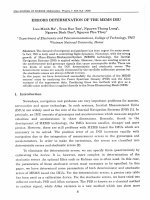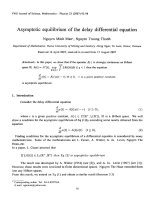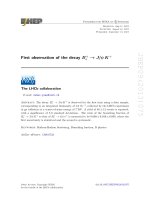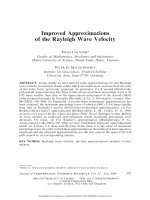DSpace at VNU: Asymptotic equilibrium of the delay differential equation
Bạn đang xem bản rút gọn của tài liệu. Xem và tải ngay bản đầy đủ của tài liệu tại đây (958.17 KB, 7 trang )
VNU Joumal of Science, Mathematics - Physics 23 (2007) 92-98
Asymptotic equilibrium of the delay differential equation
Nguyen Minh Man*, Nguyen Truong Thanh
Department o f Mathematics, Hanoi University o f Mining and Geolory, Dong Ngac, Tu Liem, Hanoi, Vìetnam
Received 16 April 2007; received in revised form 15 August 2007
Abstract. In this paper, we shovv that if the operator i4(*) is strongly continuous on Hilbert
+oo
space H, A(t) = A*(t)} sup / \\A(t)h\\dt < q < 1 then the equation
m < ĩ
T
= A{t)x(t —r), Ví >0, r is a gỉvcn positive constant,
dt
is asymptotic equilibrium.
1. Introduction
Consider the delay difFerential equation
J t x{t) = A {t)x(t - r)
( t > 0),
(1 )
vvhere r is a given positivc constant, A(-) e C(R+,L(//)), IHI is a Hilbert space. We will
show a condition for the asymptotic equilibrium of Eq (l)by extending some results obtained from the
equation
J t x(t) = A{t)x{t)
(t >
0),
(2)
Finding conditions for the asymptotic equilibrium of a differential equation is considered by many
mathematicians. Some o f the mathmaticians are L. Cezari, A. Wintcr, A. Ju. Levin, Nguyen The
Hoan,.etc.
In a paper, L. Cezari assertcd that
If\\A{t)\\ E Li(R+,Rn) then Eq (2) is asymptotic cquilibrìuTn
The result was devoloped by A. Winter (1954) (see [2]), and A. Ju. Levin (1967) (see [3]).
Hovvever, those results wcre restrictcd to íìnite đimentional spaces. Nguyen The Hoan extended thcm
into any Hilbcrt spaces.
From this result, we extend on Eq (1) and obtain a similar result (theorem 3.3)
* CorTCsponding author. Tel.: 84-4-8387564.
E-mail: ngmman@ yahoo.com
92
N.M. Man, N.T. Thanh / VNU Journaỉ o f Science, Mathemalics - Physics 23 (2007) 92-98
93
2. P relim in aries
The section vvill bc devoted entirely to the notation and concept of asymptotic cquilibriuir. of
diíĩerential equations. Almost all results of this section are more or less knovvn. Hovvever, for the
reader’s conveniencc we will quote them here and even verify several results vvhich seem to be obviuous
but not available in the mathematical literature.
Thoughout this papcr vve vvill use the íbllovving notations: H is a given hilbcrt space. r is a
givcn positive constant. C(Ịa;fe]t H ) stands for the space of all continuous íìinctions from tnc interval
[a;ò] into M. L (H ) is the set of all continous operators from H into itself.
The purpose to introduce Pro.The Hoan’s theorem 1, vve consider the íbllovving cquation:
■ ịx(t) = A (t)x (t),
vt
at
wherc i4(-) : K+ !-> £(H), A ( t ) = A '{ t)
6
M+,
(3)
(Ví 6 R), i4(") is strongly continuous.
Dcfinition 2.1. a:(-) is called a solution of Eq (3) if thcre is such to € M+,xo e M tliat x(-) is a
solution of thc following Cauchy problem:
f t x(t) = A (t)x (t)
(t > to),
x { t o ) = Xq.
Definition 2.2. [Asymptotic equilibrium] The cquation (3) is an asymptotic equilibrium equation if
all solutions o f tlic equation satisfy:
i) if a:(-) is an solution o f Eq (3) (hen x(t) tends to the íìnite limit, as t — * +oo.
ii) For a given c bclonging to H, there is such a solution x( ) of Eq (3) that lim x(t) — c.
t —*+ oo
+oo
Theorem 2.3 I f A(-) satis/ìes sup J \\A(t)h\\dt < q < 1, where T ,q are given, then Eq (3) is
||/i||< l T
a s y m p to tic e q u ilib r iu m .
To prove this theorem, we must solve the following lemma.
Note: We usually assumc that i4(-) satiíies all the conditions of theorem (2.3).
Lemma 2.4. I f x(-) is a solution o f Eq (3) then x(-) satisfìes the condition (i) o f dejìnition (2.2).
ProoỊ. Firstly, wc see, for t > T, h
6
1HI : \\h\\ < 1 ,
t
< x ( ỉ) , h > = < x (T ), h > +
J
< A(r)x(r ), h > d r ,
T
t
=< x ( T ) , h > +
Ị < x ( r ) yA ( r ) h > dr.
T
Hence,
t
\\x(t)\\ = sup II < x(t))h> II < ||x(T )|| + / \\A(t)h\\\\x(r)\\dr
ị
94
N.M. Man, N.T. Thanh / VNU Journal o f Science, Mathematics - Physics 23 (2007) 92-98
By the Gronwall-Bellman inequality, we have
/ || v4(t )/i ||<ỉt
|x(í)|| < ||x(T)||er
< ||x (T )P < + 00.
Let M := sup ||x(ỉ)||. Prom
x (t) — z(s)|| = sup II < x(í), h > —< x(s), h >
w \< \
t
p
II /
<1 J
A ( r ) h > dr\\
s
t
M sup [ \\A (r)h\\dr —>0,
\\h\\<ìJs
<
□
a s í > s - t + 00. This lemma is provcd.
The proo/ o f theorem [2.3]
Let a íixed ho € H. Consider the íunction:
+00
£1 ( í ,
h ) = < ho, h > -
Ị
< i4 ( r) / ío , h > d r ,
t> T , h
e M.
t
It is easy to show that
i) ||Ci(í,/i)ll < (1 + ?)IIM. \\h\\ < 1-
ii) ÌÌíi(í,/*)jj<(IM + 7)Ìjfc|j||M, v/>e H.
Hence, £i(í, ■) e H ' — L(H, R). By theorem Riezs, thcre is a Ii(í) € M :
Z ì(t,h ) =< X i( t),h > and ||xi(0ll < (1 + q)\\h0\\.
Let X o ( - ) =
ho.
Obviously,
^Xi(í) = A {t)x 0 {t), Ví > T .
By the same way, we establish t\vo sequcnces {£„(•,
h) =< ho, h > - / < J4(r)xn_ i(r ) , /1 > dr (í > T, n € N),
ị n { t , h) = < X „ { t ) , h > ,
(4 )
IMOII < (1 + q + • • • + qn)\\h0\\ < y~IIhoII)
[ÌXn{t) = A(t)xn- l {t) (t > T).
Moreover,
||in+i(í) - x„(í)|| =
sup II < Zn+1 (í) - x„(t), h >
NI<1
+00
< sup / | | x „ ( r ) - x „ _ i
M <1 ị
<
ữn+1
( r) | | P ( r ) / i| | c Ỉ T
N.M. Man, N.T. Thanh / VNU Journal o f Science, Mathematics - Physics 23 (2007) 92-98
95
Conscquently, {.Tn(-)} convcrges uniíbrmly on [r, +oo). Lct the limit of {xn(-)} bc x(-) belonging to
C([T, + o c), ữỉ). For a given Tị > T, By the strongly continuous property of yl(-),
sup
||j4(í)/i|| =
/€[T,r,|
AI), < +oo. Ít follo\vs from the uniformly bounded priciple, there is such a positive M ị that
sup ||^4(í)ll = Mi < +00-
teỊT .r,]
From
sup II < A {t)x u (t) - A ( t) x n- l ( t ) , h > II
||/i||
||^-x„+l(í) - •~xn(t) II =
at
at
=
\M <\
< A /i||x „(0 - x „-i(O II < A/,9n||/io||,
Ví € [r.T x],
the sequence {^x„(')} convergcs uniformly to ^ịx(-) on (T ,T \).
On the other hand,
+00
< x n (t), h >=< ho, h > - Ị <
t
Letting n —> + 00, we have
A (t)h > dt
(t € Ịr,Ti]).
+00
< x(t), h > = < ho,h > -
J
< x(t), A (t)h > dt
( t e [T, T\]).
t
It lcads to < jỊịx(t)ịh > = < /l(f)x(í), h >,
v/i E H, £ £ (T,Ti). By a any given T\ > T,
ị x ( t ) = A (t)x (t) y Ví > T.
dt
Observe that
+00
||x(í) - /loII = sup II < x(t) - ho, /1 > II = sup II / < x(r), i4(r)/i > cZr||
IWI<1
IW<1
J
+00
-..S
“P í llj4(T)/lỉldr7T—IIM
||h||
°'
as t —*+ 00. This is proved the theorem.
3. The m ain result
In the section, we vvill extend Pro.The Hoan’s result to the following delay diíĩerential equation:
Ỵ 'x (t) = A (t)x (t - r)
( Í 6 R+),
where r is a given positive constant, A(-) satisfies all the conditions in the section 2.
(5)
96
N.M. Man, N.T. Thanh / VNU Journal o f Science, Mathematics - Physics 23 (2007) 92-98
Definition 3.1. x (-) is called a solution of Eq (5) if thcre is such to 6
that x(-) is a solution of the following Cauchy problem:
€ C (Ị*o — r,/o ],H )
Ị ẳ x i t ) = A (t)x (t - r ) (< > í0)'
= ¥»•
If x ( ‘) is a solution of Eq (5), then x ( - ) satifies the condition (i) of definition [2.2].
L e m m a 3 .2 .
P r o o f.
From
t
< x (í), h > = < x (s ), h > + I
< A ( t )x (t — r ) , h >
d r
( t > s > T ),
s
we havc
t
||x(í)|| = sup II < x (t), h > II < ||x(s)|| + sup [ ||i4(r)/i||||x(r - r)||dr, t > s > T + to-
l|fc|
\m<ì J3
Hence,
IIMOII
sup
or 111(011
i> s> r +
(o,
||z(OII* Lct M := sup ||x(í)||.
t>Lo-r
* o - r < í< í
On the other hand,
t
||x(í) —x(s)\\ = sup II< x(t) - X(s), h > II= sup
IN<1
<
II / <x ( t — r), A (r ) > dr\\
s J
t
M sup 1||y l(r)/i||c /r —♦ 0,
m < i Js
as t > s —>+oo. The lemma is proved.
□
Thcorem 3.3. The Eq (5) is asymptotic equilibrium.
ProoỊ. Let a fixed /lo 6 H.L We considcr the following iunction:
íunction:
*foo
, h ) =< ho, h > - j
< A (r)h ũ , h > d r
(t > T ).
t
Let X o (t) = 0. ưsc cxactly the argument of the proof of theorem 2.3, we establisli the functions
Xi(-),z7(-) which satisíy :
For t > T,
i)
=< x ĩ { t) t h > ,
ii) í * ĩ ( t ) = A{t)x0(t),
iii) xĩ( < ) = Xl (í),
iv) 11*1(011 < (l + g)IIMBy the same way, we have three sequences
/i)}» {^n(0}» {^Ẽĩĩ(0} which satisíy :
N M . Man, N.T. Thanh / VI^ỈU Journaỉ o f Science, M athematics - Physics 23 (2007) 92-98
97
+oo
J
0 £ n (f, h ) = < X ^ ( t ) , h > = < h o ,h > -
= A [ t)x n - 1 (t - r ) ,
ii)
iii)
x n (t) =
< A ( T ) x n- i ( T - r), h > d r
(t >
T
+ r)
Ví > T + r.
x^ (t), t > T + r,
x ^ ( T + r), T + r > t > T.
iv ) ||x n (t)|| < (1 + 9 + ••■ + 9n )||Ao|| < r = ĩ l l M i
We seo that
||x „ + i( í ) - x n (í)|| =
t>T.
sup II < z n + i( f ) - x n{t),h >
l|fc||
< sup [ ||xn(r - r) - x „ -i(r - r)||||>l(r)/i||d
||h||<
ÍVn eE N,
N . tí > TT + r).
r'
(Vn
ơn+11 ||/i0||
ll/inll
gn+
Moreover, ||xn+i (í) - x n(t)\\ < qn+ì ||/io||, Ví > T, n € N.
Conscquently, {xn(-)} convcrgcs uniíbrmly on [T, + 00). Let the limit of {Zn(-)} bc x(-) belonging
to C([T, + 00), H). Frorn
4 -0 0
< X n+1 (t), h >=< h o ,h > — J
< x n (r - r), A ( r ) h > d r
(t > T + r),
t
letting n —►+ O C , wo have
+00
< x(t), h >=< h o ,h > -
Ị
< x ( t - r), A ( r ) h > d r
(t > T + r).
t
On the other hand, for a given anv T\ > T 4- r, the sequence { jiX n (t)} converges uniformly on
(T -4- r, Ti](see prooí of theorem 2.3). This leads to
ị - x { t ) = lim -7 -a:n(í) vt > T + r.
n -H -o o d t
dí
Hence,
-7 -x(£) = j4(£):r(í —r)
cu
> T,
By ||x(t)| <
> T + r.
+oo
||x ( í ) -
/lo l
=
sup
II <
x ( í)
-
h o , h > II =
IWI<1
sup
PII<1
II
/
{
<
x
(t —
r), A (r)h
> d r II
+oo
- |W
sup
|<1 Jí M(T)/ỉlláTT~1 - 9 ll/loll _+0’
as t
>+ C C . This is proved the theorem.
□
98
N.M. Man. N.T. Thanh / VNU Journal o f Science, Malhematics - Physics 23 (2007) 92-98
References
[1] L.Cezari, Asymptotic Behaviour and Stability Problems in Ordinary Dijferentiaỉ Equations, "Mir” Moscovv, 1964.
[2] A.VVintcr, On a Thcorcm o f Bochcr in The Theory of Ordinary Lincar Diíĩercntial Equations, Amer J.Math. 76 (1954)
183.
[3] A.Ju.Levin, Limiting Transition for The Nonlinear Systems, Doki Akad. Nauk SSSR 176 (1967) 774 (in Russian).
[4] Nguyen The Hoan, Asymptolic Bahaviour o f Solutions of Non Lincar Systems of Diíìcrcntial Kqualions, DiJJereníiỉnye
Uravnenye 12 (198ỉ) 624 (in Russian).









